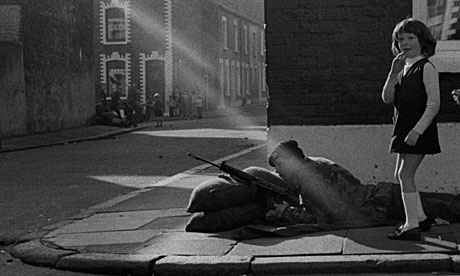The term "state murder", deployed in today's Guardian preview of the Saville report on Bloody Sunday has a particularly chilling ring. Is it not the primary duty of states, for all their imperfections, to provide external protection and internal security for their citizens? It is. Without both, societies cannot flourish.
Clearly this did not happen in Derry – then more likely to be called Londonderry – on that fateful Sunday afternoon, 30 January 1972, when members of 1st Battalion, the Parachute Regiment, shot dead 13 civil rights marchers (a 14th died of his wounds later) in circumstances hotly disputed at the time.
I can remember thinking then that the Paras had probably run amok because that's what tough-guy parachute regiments did; witness Gillo Pontecorvo's memorable film The Battle of Algiers (1966), which featured brutal French paratroopers and was still fresh in many minds.
That was the view of reporters then in Northern Ireland, including Simon Hoggart, as well as of regular regiments. They disliked the tendency of the Paras to stir things up and undo their calming efforts, if not to win hearts and minds, then at least to placate them. Forty British soldiers had been killed by republicans in Northern Ireland during 1971.
Lord Widgery's original inquiry, well on the perfunctory side, concluded that the squaddies had been no more than "bordering on reckless" (and the dead had, he said, been handling firearms) so the controversy has festered ever since.
When Tony Blair agreed to appoint Lord Saville – as a side deal to the Good Friday agreement in 1998 – he must have envisaged a brief, cathartic inquiry, not one lasting 12 years and costing £191m.
Henry McDonald's thorough reports in today's paper state that Saville will announce on Tuesday that unidentified soldiers were guilty of unlawful killing, most conspicuously Soldier F, who may have shot as many as six people that day, Soldier G (now dead), almost as many. Two men causing all this trouble? Oh dear.
As we have all re-learned in Iraq, the line between good soldiering, fired up by a dramatic confrontation's adrenalin rush, and brutal or psychotic misbehaviour can be a fine one. It is an old story and much depends on strong leadership. The Roman soldier who killed Archimedes at the end of the siege of Syracuse (212 BC) was disobeying orders: he just got carried away.
But before we get to the tricky bit – what happens next? – it's worth glancing at context.
Like many, but not all, famous massacres – Glencoe and Peterloo spring to mind – the number of casualties involved were comparatively few, 15 at St Peter's Square in Manchester in 1819 compared with an official 379 dead and 1,100 wounded (though Indian estimates are much higher) when panicky British troops fired on demonstrators at Amritsar in 1919.
Whatever the scale, the real significance is usually political. Unwarranted heavy-handedness by Paras or Dragoons undermines the state's legitimacy and creates pressure for reform or – in both India and Ireland's case – for independence.
Thus woefully oppressive mishandling of the Easter rebellion in Dublin (1916) tilted Ireland towards independence. Bloody Sunday did not, though it legitimised the far bloodier activities of the IRA and the Protestant contras for the next 25 years.
As for Glencoe (1691), it came to symbolise grievance and secessionist Scots tendencies which have not been assuaged by the Act of Union, the Jacobite rebellions or even by devolution.
Such is the power of martyrdom, as some of the activists on the blockade-breaking Gaza convoy must have calculated only the other day, when the state of Israel ended up in the dock.
It has defended itself as the British government did after Bloody Sunday, buttressed by the conviction that they both acted to defend law and order – as perceived by the majority – against the forces of disorder, subversion and worse. Read a book like Kevin Toolis's Rebel Hearts if you want an unsentimental view of the Provos.
By coincidence today's Guardian provides a different sort of context on other news pages. Angus Stickler and Maggie O'Kane have interviewed disaffected, on-the-run members of Iran's Revolutionary Guard for insights into that dysfunctional and fearful tyranny that may – may – be toppled at any time.
There again, as Ian Black points out, it may not because the opposition – the remnants of last year's pro-democracy "green revolution" – is divided and cowed by judicial killings, imprisonment and repression.
How many people were killed in Iran's post-election demos? Thirty-six, say some. Far more, say others. But the repression is real enough and it has seriously eroded the legitimacy of the Islamic regime, which overthrew Iran's last tyranny – the Shah's – in 1979, only to slide into corruption and ineptitude itself.
Iran will come through the travails of achieving its modern identity; an ancient society with a spectacular history, it is struggling to adapt after centuries of decay. Can we confidently say the same of Serbia – which has also been struggling for centuries – on the day after two Bosnian Serb officers were finally jailed for their role in the Srebrenica massacre of 1995?
Here is the modern massacre that really puts most of the above into the shade. In one of his reports in today's paper, Ian Traynor compares it with Guernica, Oradour-sur-Glane, Katyn and Auschwitz, all powerful symbols of man's beastliness to man, but each worth differentiating.
A talented Times correspondent and Spanish republican sympathiser, George Steer, brought the German bombing of Guernica (1937) to the world's attention and Picasso's painting did the rest. Fewer were killed than at Oradour, the German revenge on the Maquis for attacks on an SS Panzer division racing towards Normandy in 1944. French road signs directing the tourists to the ruined village are, incidentally, much bigger now than a few years ago.
Both are primarily symbolic and besides, they took place during extensive wars. The scale of Katyn (as many as 15,000 Polish officers murdered at Stalin's behest in 1940), the horrors of Auschwitz and Srebrenica make them the real, chilling deal. Can you imagine it, 8,000 Muslim men and boys murdered on the edge of the sleepy and peaceful European Union in 1995? It is the most shocking thing to happen in western Europe in my lifetime.
So Bloody Sunday needs to be placed in context, hard though it must be for those whose lives were utterly changed by it and have found it impossible to move on without first obtaining redress.
Should prosecutions be launched 30 years after the event? If viable evidence can be mustered from the millions of words of long-ago recollection, that is the logic of Blair's mandate to Saville and the report's conclusion. There is no immunity under Saville rules for anyone committing perjury.
But prosecution will surely only trigger tit-for-tat demands for justice against known republican killers on the grounds that – as McDonald reports – some of the Troubles dead seem to be "more equal than others".
We will have to talk it through in the weeks and months ahead, give it a final airing. But I suspect the wise answer may be to let it go after that, once we know – at £191m let's hope we do – what actually happened and why.
I leave you with a paradoxical thought, that if a more warlike bunch of UN soldiers than the Dutch peacekeepers had been in Srebrinica that fateful day in 1995 they might well have faced down the Serbian warlords and prevented the massacre. The Paras perhaps?
The future General Sir Mike Jackson was second in command of 1st Battalion, the Parachute Regiment in Derry in 1972. When he refused US orders to blockade Russian forces at Pristina airport in 1999 ("I won't start World War III for you") he reminded us that leadership can make a difference – and the difference between military heroism and brutality can be a fine one.








